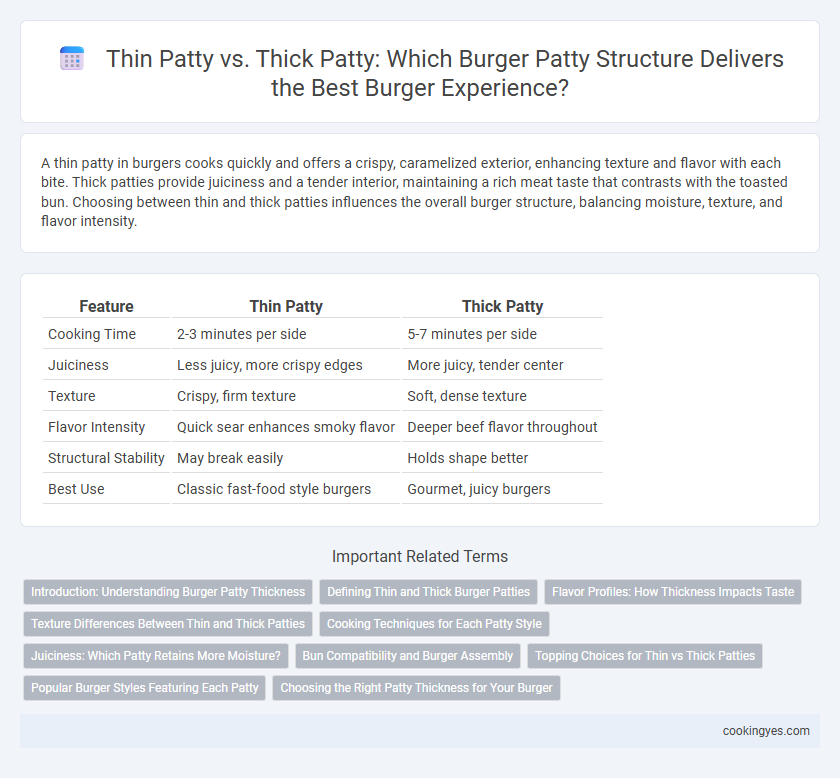A thin patty in burgers cooks quickly and offers a crispy, caramelized exterior, enhancing texture and flavor with each bite. Thick patties provide juiciness and a tender interior, maintaining a rich meat taste that contrasts with the toasted bun. Choosing between thin and thick patties influences the overall burger structure, balancing moisture, texture, and flavor intensity.
Table of Comparison
| Feature | Thin Patty | Thick Patty |
|---|---|---|
| Cooking Time | 2-3 minutes per side | 5-7 minutes per side |
| Juiciness | Less juicy, more crispy edges | More juicy, tender center |
| Texture | Crispy, firm texture | Soft, dense texture |
| Flavor Intensity | Quick sear enhances smoky flavor | Deeper beef flavor throughout |
| Structural Stability | May break easily | Holds shape better |
| Best Use | Classic fast-food style burgers | Gourmet, juicy burgers |
Introduction: Understanding Burger Patty Thickness
Thin burger patties cook faster and develop a crispy outer layer that enhances texture and flavor through the Maillard reaction. Thick patties retain juiciness and offer a tender, meatier bite but require careful cooking to maintain even doneness throughout. Choosing between thin or thick patties impacts burger structure by influencing moisture retention, cooking time, and overall taste experience.
Defining Thin and Thick Burger Patties
Thin burger patties typically measure about 1/4 inch in thickness, allowing for a crispier exterior and faster cooking times. Thick burger patties range from 3/4 inch to over 1 inch, offering a juicier interior and a more substantial bite. The choice between thin and thick patties influences the burger's texture, cooking method, and overall flavor profile.
Flavor Profiles: How Thickness Impacts Taste
Thin burger patties sear quickly, creating a caramelized crust that enhances savory, smoky flavors with a higher ratio of browned surface to meat. Thick patties retain more internal moisture, resulting in juicier bites and a pronounced beefy taste, but may sacrifice crust development. The thickness directly influences flavor intensity and texture contrast, shaping the overall burger experience.
Texture Differences Between Thin and Thick Patties
Thin burger patties offer a crispy edge and a higher surface-to-volume ratio, creating a more pronounced caramelization and a crunchy texture. Thick patties retain juiciness and provide a tender, soft interior due to less direct heat penetration, resulting in a beefier bite. Texture differences significantly influence overall burger experience, balancing between crispness in thin patties and succulence in thick ones.
Cooking Techniques for Each Patty Style
Thin patties cook quickly using high heat methods like griddling or pan-frying, creating a crispy exterior and juicy interior due to rapid Maillard reaction. Thick patties require lower, slower cooking techniques such as grilling or baking to ensure even heat penetration and prevent a raw center. Adjusting cooking times and temperatures optimizes texture and flavor distinct to each patty style.
Juiciness: Which Patty Retains More Moisture?
Thin burger patties cook faster, allowing less time for moisture to evaporate, which helps them retain juiciness despite their smaller size. Thick patties, while larger and potentially more flavorful, often lose more moisture during the longer cooking process, leading to a drier interior if not cooked carefully. Proper cooking techniques, such as adjusting heat and timing, are crucial to maximizing juiciness in thick patties.
Bun Compatibility and Burger Assembly
Thin patties offer superior bun compatibility by reducing bulk and preventing the bun from becoming overly compressed, ensuring a balanced bite in burger assembly. Thick patties can cause buns to become soggy or difficult to close, complicating the layering process and potentially leading to structural instability. Choosing the appropriate patty thickness optimizes the burger's overall integrity, texture, and ease of handling during consumption.
Topping Choices for Thin vs Thick Patties
Thin burger patties allow for a wider variety of delicate toppings such as caramelized onions, sauteed mushrooms, and fresh arugula, which complement their quick cooking time and enhance flavor without overpowering the meat. Thick patties pair well with robust, hearty toppings like melted cheddar, crispy bacon, and grilled jalapenos that add texture and intensity, balancing the juiciness and richness of the beef. Choosing the right toppings based on patty thickness optimizes taste and structural integrity, ensuring each bite delivers a harmonious blend of flavors and textures.
Popular Burger Styles Featuring Each Patty
Thin patties are essential in classic American sliders and smash burgers, where the focus lies on a crispy seared edge and quick cooking time, enhancing flavor through Maillard reaction. Thick patties dominate in gourmet and smash-style burgers like the Big Juicy Burger or the classic Cheeseburger, providing a juicy, tender interior and a satisfying bite. Each patty type influences the texture and overall eating experience, shaping popular burger styles worldwide.
Choosing the Right Patty Thickness for Your Burger
Choosing the right patty thickness is essential for achieving optimal burger structure and flavor balance. Thin patties cook quickly, allowing for a crispy edge and juiciness in a shorter time, ideal for stacked burgers with multiple layers. Thick patties retain more moisture and provide a meatier bite, but require careful cooking to ensure even doneness without drying out the center.
Thin patty vs thick patty for burger structure Infographic

 cookingyes.com
cookingyes.com